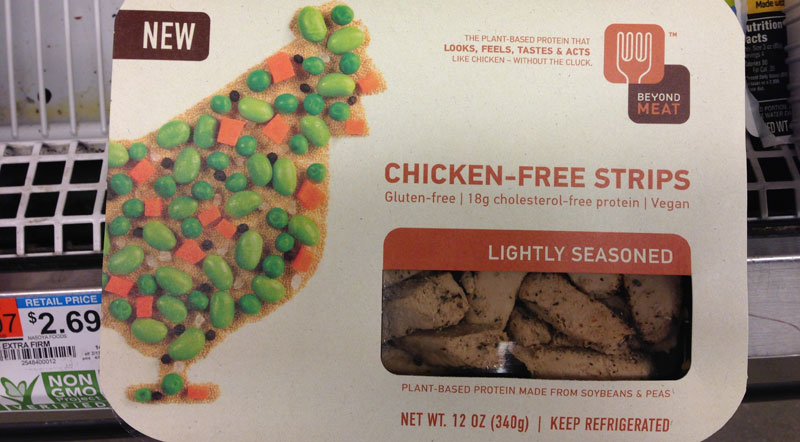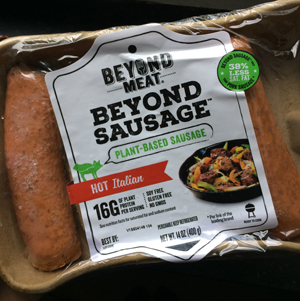
Beyond Meat’s plant-based products. Image source: Flickr Image.
Every investment comes inherently with risk and it’s no exception for buying Beyond Meat (NASDAQ:BYND)‘s common stocks. For a company as new as Beyond Meat, and whose business model may not have been fully proven, the investment in its common stocks comes with even greater risks.
Moreover, the company’s common stocks have been trading at a sky-high valuation with respect to ratios such as price to sales, price to shareholders’ equity as well as the price to earnings ratio, suggesting that there is much more than just expectation being baked in the stock price.
For any reason, any slightest mishaps or negativity associated with the company or its plan-based meat products will result in not a plunge but a crash in the stock price when it’s trading at such a stratospheric level.
In this article, we will look at several risk factors associated with investing in Beyond Meat’s common stocks.
Without further ado, let’s jump in.
Beyond Meat’s Investment Risk Topics
1. Risk 1: COVID-19
2. Risk 2: Profitability
3. Risk 3: Beyond Burger
4. Risk 4: Lack Of Capital
5. Risk 5: Co-Manufacturers
6. Risk 6: Ingredients
7. Risk 7: Consumers’ Taste
8. Risk 8: Competition
9. Risk 9: Dividends
10. Conclusion
Risk 1: COVID-19 has severely affected BYND’s Sales
Without any doubt, the biggest risk factor affecting Beyond Meat’s business operation, and possibly the stock prices, would be the COVID-19 outbreak which started at the beginning of 2020.
According to this article, Beyond Meat’s revenue breakdown, the company’s foodservice channel revenue tumbled significantly to only $106 million in FY2020, representing a year-on-year decline of more than 30% compared to the prior year.
While foodservice revenue recovered in 2021 to $140 million, it was still roughly 8% lower than that of fiscal 2019, illustrating that this important revenue source still hasn’t recovered to its pre-pandemic level.
The decline in the foodservice revenue started in 1Q20 and persisted throughout the 2nd half of 2020. Undoubtedly, the decline was largely driven by the COVID-19 disruption which has forced many of Beyond Meat’s foodservice customers to temporarily close bars and restaurants.
In addition, Beyond Meat’s international sales also plunged dramatically to $82 million in FY2020 compared to $98 million reported a year ago.
Fortunately, this particular revenue segment recovered in 2021 to a massive $145 million, nearly double that of 2020 and roughly 48% higher than that of 2019.
While international revenue has recovered, it is the opposite for U.S. sales.
In 2021, Beyond Meat’s U.S. sales were only in line with that of 2020, a totally different story compared to having a growth rate of more than 60% in 2020 and a nearly 200% growth rate in 2019.
As a result, Beyond Meat’s poor U.S. sales results, and also retail sales, have been a drag on its stock price since 2021.
As of Dec 2022, Beyond Meat’s stock price was down more than 70% to only $15.
Despite trading at dirt cheap, Beyond Meat’s stock price shows no sign of recovery.
The reason is that investors do not know if its U.S. sales and retail sales will ever recover, even in a post-pandemic world when much of the stay-at-home restriction has been lifted.
Risk 2: Beyond Meat has never made a profit on a yearly basis
Just like any other startup, Beyond Meat has never been profitable on a yearly basis. In fact, the company has experienced net losses in almost every period since its inception.
Particularly, Beyond Meat has net losses in the past 4 years totaling $53 million, $12 million, $30 million, and $30.4 million in fiscal 2020, 2019, 2018, and 2017, respectively.
Beyond Meat’s net loss was even worse in 2021, totaling a massive $182 million, and higher than the net losses of the previous 4 years combined.
To make matter worse, Beyond Meat has anticipated that net losses will continue for the foreseeable future due largely to the increase in operating expenses as well as capital expenditure.
These investments are required and necessary for the company to expand its distribution and manufacturing facilities as well as to increase the marketing channels and supplier network.
For the reason discussed, buying Beyond Meat’s common stocks while the company is making losses is purely speculating on the future of the company.
Due to the persistent losses, Beyond Meat could go bankrupt at any time if it failed to obtain the necessary capital to operate and expand the business.
The bankruptcy of BYND could result in a total loss of your investment in the company’s common stocks.
Risk 3: Beyond Meat counts on a single product for growth
In this aspect, Beyond Meat’s flagship plant-based meat product, Beyond Burger, has been the company’s main driver for growth in the last 4 years.
Precisely, Beyond Burger accounted for as much as 55%, 58%, 64%, 70%, and 48% of gross revenues in fiscal 2021, 2020, 2019, 2018, and 2017, respectively, based on the 2021 annual report.
In the foreseeable future, the company anticipates that Beyond Burger will continue to constitute a significant portion of revenue, income, and cash flow.
For this reason, there is a significant risk associated with the company counting on a single product for growth. Any mishaps such as a product recall related to food safety or a change in consumers’ perception that the Beyond Burger may not be as healthy as advertised could result in a catastrophic disaster for the company.
If this sort of incident ever occurs, Beyond Meat could experience a plunged in sales and subsequently, the price of its common stocks.
Risk 4: Beyond Meat relies on external capital to survive
From time to time, Beyond Meat needs additional funds to expand into new markets. Other than expansion, the company also needs funds for research and development, manufacturing and supply, marketing, and selling existing as well as new products.
Unfortunately, Beyond Meat’s business operation has been unable to generate sufficient cash flow to pay for all of these expenses.
According to this article, Beyond Meat’s free cash flow, the company has been consuming a large amount of cash, resulting in negative operating and free cash flow.
As such, the company has been relying on external capital through public or private equity as well as debt financing to obtain the necessary cash to keep the business running.
Keep in mind that these financing methods could result in the dilution of stockholders, imposition of debt covenants, an increase in repayment obligation, and other restrictions.
All of these events could possibly lead to the company going under if the business unexpectedly deteriorates, resulting in the failure of the company to further obtain the necessary financing.
Risk 5: Beyond Meat relies on co-manufacturers to produce its products
Instead of manufacturing and packaging the final product itself, Beyond Meat relies mostly on co-manufacturers to produce the final products that will be shipped out directly to its distribution channels.
In other words, a significant portion of Beyond Meat’s revenue is derived from products manufactured at manufacturing facilities owned and operated by the company’s co-manufacturers.
According to the company’s 2019 annual report, Beyond Meat has written contracts with only 1 co-manufacturer in the U.S.
Since then, Beyond Meat has never disclosed in its annual reports the number of contracted co-manufacturers.
The disadvantage of this business model is that the co-manufacturers could terminate the relationship with Beyond Meat at any time, leaving the company with periods during which Beyond Meat has limited or no ability to manufacture its products.
A lack of competent and high-quality co-manufacturers in the industry that meet Beyond Meat’s strict quality and control standards has forced the company not to pursue any written contracts.
However, this practice has posed significant risks to the company.
For instance, Beyond Meat terminated a supply agreement with Don Lee Farms, one of its co-manufacturers, in 2017 due to a breach of a supply agreement. In the incident, it was claimed that Don Lee Farms has failed to provide saleable products, as certain products manufactured by Don Lee Farms were contaminated with salmonella and other foreign objects, resulting in food safety issues.
In return, Don Lee Farms filed a lawsuit against Beyond Meat, costing the company $4.9 million, $1.5 million, and $3.5 million in restructuring expenses in 2019, 2018, and 2017, respectively.
With this said, utilizing low-quality co-manufacturers can cause not only monetary damages but also food safety issues which will further damage the company’s brand, and subsequently the stock price.
Risk 6: Beyond Meat may face difficulties in sourcing ingredients
One of Beyond Meat’s main ingredients, pea protein, comes directly from the yellow pea. The company is sourcing this ingredient from only a handful of countries such as Canada, France, China, and the U.S.
The harvest of this crop could easily be affected by a number of factors, such as adverse weather conditions, natural disasters, and pestilence, which are beyond the company’s control.
Additionally, climate change is another factor that may disrupt the supply of pea protein when rising temperatures and extreme weather conditions can easily damage crops.
All of these events can lead to a supply constraint and result in a jump in the price of the ingredients.
According to the 2021 annual report, a hypothetical 10% increase in the weighted average cost of pea protein, could result in an increase of $3.0 million in the cost of goods sold.
If an ingredient supply constraint does occur, Beyond Meat could incur significantly higher costs of goods sold, thereby leading to lower profitability, and eventually lower stock price.
Risk 7: Consumers’ preference for Beyond Meat’s products is hard to predict
Another risk that Beyond Meat is facing is related to consumers’ preference for its plant-based protein products.
In this aspect, consumer trends that are now favoring sales of Beyond Meat’s plant-based meat products may not necessarily last forever and can possibly change at the drop of a hat.
There are a number of factors affecting consumers’ preferences, including a shift in preference from plant-based meat products back to animal-based products.
Moreover, Beyond Meat has also been facing a number of smear campaigns initiated by lobbyists supporting the meat industry in an attempt to drive the company out of the market.
These campaigns are targeting Beyond Meat’s plant-based meat products and alleging that they are not as healthy as advertised by the company.
Any shift in consumers’ preference from Beyond Meat’s plant-based meat products to animal-based products will certainly result in lower sales, and thus, lower stock prices.
Risk 8: Beyond Meat operates in a highly competitive industry
Other than the conventional animal-protein companies, Beyond Meat is also facing stiff competition from companies that produce plant-based meat products.
Companies such as Impossible Foods, Sysco, Hormel, and Kraft Heinz are a few examples that also develop and sell plant-based protein products. Some of these companies are more established than Beyond Meat and have much greater resources to bring new products to market faster and can quickly exploit and serve niche markets.
In other words, they have the resources to compete effectively with Beyond Meat.
Aside from competing head-to-head with animal-based and plant-based protein products, Beyond Meat is also facing another uphill battle with a new type of product called “clean meat”.
The “clean meat” is a type of animal-based meat that is grown in the lab instead of being taken from animals grown in the farms.
Some companies have successfully developed “clean meat” using cells extracted from animals and then cultivating these cells into animal-based protein products.
When these products are getting more established in terms of cost and appeal, they will pose a much greater risk to Beyond Meat’s plant-based meat products and can eventually take the market share away from the company.
Risk 9: Beyond Meat does not pay a dividend
This factor may not necessarily constitute a risk. However, investors who are expecting the company to pay dividends will be disappointed.
For your information, Beyond Meat has never paid any dividends on its common stocks since its IPO in May 2019. And the company does not intend to pay any dividends for the foreseeable future according to the 2019 annual report.
As discussed in the prior risk factors, Beyond Meat has been unprofitable and also has been having a cash-flow deficit. The company needs to keep every single dime that it earns to run the business.
Therefore, Beyond Meat anticipates retaining all future earnings for use in the operation of the business and for general corporate purposes.
When a company doesn’t pay a dividend, the only way for investors to make money off the stock is through price appreciation of the common stocks.
For this reason, investors who buy Beyond Meat’s common stocks would have to speculate that the company will be having better sales in the future and thus, a higher stock price.
Conclusion
In summary, Beyond Meat is a great company with one of the most innovative products on earth. However, a great company does not necessarily mean that it will be a great investment.
Investors looking to buy Beyond Meat’s stocks need to be prudent and should consider all the risks discussed in this article.
Prior to 2022, Bynd’s stock was traded at a sky-high valuation , suggesting that all the good news for the company was priced in.
Therefore, as of 2022, Beyond Meat’s share price tumbled to less than $15 and was down 70% because the company missed several analysts’ expectations and sales had been really ugly.
For this reason, investors need to think twice before plunging their dollars into the stocks as the investment into BYND does come with high risks.
References and Credits
1. All information such as financial numbers and statistics in this article was obtained and referenced from Beyond Meat’s financial reports available in Beyond Meat SEC filings.
2. Featured images in this article are used under creative commons license and sourced from the following websites: James and Sid Sowder.
Top Statistics That You Might Be Interested
Disclosure
The content in this article is for informational purposes only and is neither a recommendation nor a piece of financial advice to purchase a stock.
If you find the information in this article helpful, please consider sharing it on social media and also provide a link back to this article from any website so that more articles like this one can be created in the future. Thank you!










